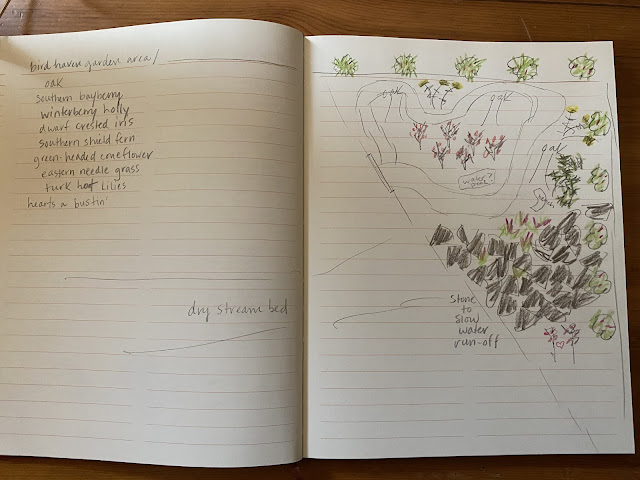Yesterday I put extra plantings of white wood aster and wild ginger in the shade bed. These have previously been featured in my series, so I won’t add them in again today. I have a few more things to add to this shade bed this year and can’t wait to see the layers these new plants will create in this area.
Today when we get a break in the rain, I’ll be carting a nice grouping of dwarf crested iris down the hill to the bird haven bed.
When I start thinking about a new garden space I usually do some kind of sketch like this to get a visual of what I’m trying to do.
I sometimes deviate from the original sketch, but it’s always a useful endeavor to think about what I envision eventually being in the space.
More on dwarf crested iris, from NCSU’s plant site:
Iris cristata
Common Name(s):
Previously known as:
- Evansia cristata
- Iris glumacea
- Iris odorata
- Phonetic Spelling
- EYE-riss kris-TAY-tah
- This plant has low severity poison characteristics.
- See below
- Description
Dwarf Crested Iris is a native species of Iris that grows in North Carolina. It reaches only 4-9 inches tall and spreads to form a groundcover in its native peaty woodland habitat. It offers an early perennial spring bloom in partly shady areas and grows well in rock gardens and woodland sites. Following the blooms, the foliage is useful as a ground cover in the woodland shade.
This plant grows best in partial sun to partial shade, preferring rich, well-drained soil. A too rich soil will encourage foliage growth and no blooms. It can tolerate full sun but needs more moisture. Use this plant for a ground cover in partly shady areas of rock gardens, woodland sites or in a perennial border. It is resistant to damage by deer.
Insects, Diseases, and Other Plant Problems: Slugs and snails.



No comments:
Post a Comment
Thanks so much for taking the time to comment - I love reading them and respond as often as I can. I also love comments that add to the original post, so feel free to share your own experiences, insights, and thoughts.